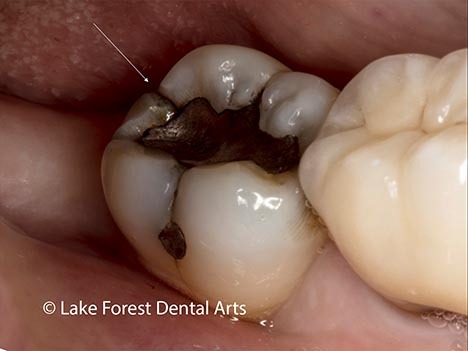
Dentists are trained to see the difference between the three cracks in this tooth. The one with the pointer is a critical crack that will extend further if left without repair.
If you’ve sustained an injury to the face or mouth, habitually grind your teeth, or cracked or fractured a tooth from trauma or for any other reason, it might immediately become sensitive. The toothache can warn you that your tooth is in danger and prompt you to seek appropriate treatment. However, not all tooth cracks are sensitive or obvious. A cracked tooth will not always hurt. Treatment depends on the location and severity of the fracture. Every tooth is unique, and so are the cracks that can threaten them. Before dentists can treat your damaged tooth, your dentist will thoroughly examine the tooth to determine the most appropriate course of treatment.
Types of Cracks
Cosmetic Craze Lines
Tiny cracks, called craze lines, can affect the surface area of a tooth’s enamel without compromising the tooth itself. Enamel is the semi-translucent layer of minerals that surrounds and protects your teeth. Craze lines can mar the appearance of your smile, especially if stains develop along them, but they don’t threaten your enamel or your tooth’s integrity.
Fractured Cusp
The cusps of a tooth are the upraised portions of its chewing surface (such as those on molars). If a piece of the tooth’s surface breaks off, then the damaged tooth can often be treated by placing a dental crown over it. The extent of damage doesn’t usually threaten the tooth’s pulp, or mass of nerves and blood vessels at the center of the tooth. It also shouldn’t generate discomfort, although some patients do experience sensitivity to hot and cold temperatures, food debris, and bacterial irritants after losing a piece of tooth.
Deep Tooth Crack
Typically, a crack will extends from the crown vertically towards the root of the tooth. If left untreated, they can extend from the surface of the tooth all the way to the tooth’s pulp. If it reaches the pulp, then it can expose the sensitive tissues to bacteria and infection. A root canal procedure to protect the tooth from an internal infection would be required. If it extends below the gum line and affects the root can render the tooth useless and will require a tooth extraction to prevent damage to surrounding tissues.
Split Tooth
If you ignore a crack, the fracture will only worsen. Eventually it can lead to tooth loss or necessary extraction. For instance, a typical crack will continue to grow until the tooth is split into two distinct pieces. A portion of a split tooth can, in some cases, be retained; however, split teeth cannot be saved as a whole, and often require extraction.
Root Fracture
Vertical root fracture
Unlike a conventional crack, which begins at the crown, a vertical root fracture describes a crack that begins with your tooth’s root and extends towards its crown. A vertical root fracture may not cause toothaches and pain, and often VRF’s can go unnoticed until the surrounding jawbone and gum tissue become infection. Root canal treatment or endodontic surgery can sometimes save the tooth by removing a split part of the tooth. More often, the tooth requires extraction and possibly replacement with a dental implant.
Horizontal root fracture
Roots can break in a horizontal direction also. These fractures will always weaken the support for the crown. Horizontal root fractures don’t always cause the loss of the tooth or require a root canal. Long term oversight is needed for these fractures.
The future of your fractured or cracked teeth
Like tooth decay and gum disease, a dental injury will continue to grow worse until actively treated, and the future of your tooth depends on how quickly it’s treated. In many cases, a lifelike porcelain dental crown can be placed over the cracked tooth to hold it together and protect it the future pressures of biting and chewing. If your tooth is too severely damaged to be saved, your dentist may recommend replacing it with a dental implant after it’s been extracted. A dental implant is a prosthetic root device that’s surgically inserted into the jawbone, and can support a dental crown once the jawbone has healed.
Cut out the bad habits
Damage to teeth often occurs from bad oral habits. Chewing ice or crunchy snacks often leads to tooth fracture. These things can crack a tooth easily.
Dr. Fondriest combines his impressive array of experience with modern technology and caring, compassionate, and knowledgeable staff, and we proudly serve patients from Chicago and all surrounding communities. To schedule your consultation, call our office today at (847) 234-0517.
Dr Fondriest is a Nationally recognized and highly sought after cosmetic dentist. He serves clients from throughout the United States
